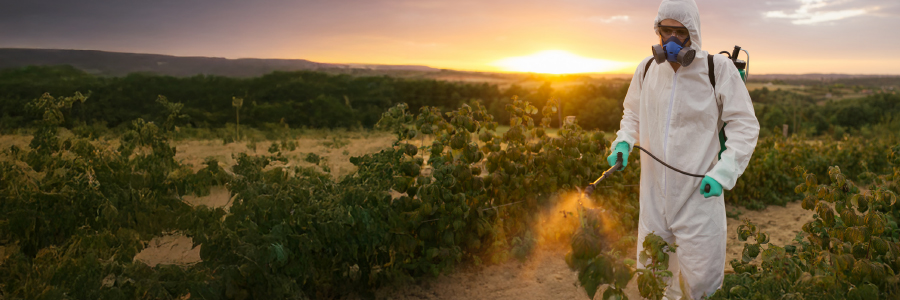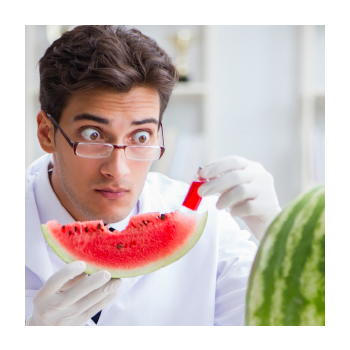Consumer Reports review finds that pesticides pose “significant risks” in 20% of the fruits and veggies they examined7
Analyzing seven years of USDA pesticide residue data on 59 common foods, they categorized the pesticide exposure risk from very high to low.8 They determined risk levels by combining the number of pesticides found on the sample, how often they showed up on that food, the detected levels of each chemical, and its toxicity.9 Twelve fruits and veggies were rated as high or very high risk (including potatoes, strawberries, and green beans), ten as moderate, and the remainder as low risk.10 The primary contributors to risk were two chemical classes: organophosphates, which can harm the nervous system and negatively impact children's developing brains, and carbamates, which may disrupt endocrine functions and adversely impact the male reproductive system.11 12 13 14
A sampling of Consumer Reports’ high-risk produce findings
- Blueberries: One in five U.S.-grown conventional blueberries contained phosmet residue, an organophosphate pesticide the EPA considers particularly risky for children.15 The Environmental Working Group's (EWG) 2024 Shopper’s Guide to Pesticides in Produce™ also weighs in, citing EPA findings that blueberries are a "major contributor" to phosmet exposure in babies and children's diets.16
- Kale and Mustard Greens: Conventional kale and mustard greens samples contained a cocktail of synthetic pesticides, including pyraclostrobin and cyfluthrin, which research has linked to poor outcomes for cardiovascular disease.17 Additionally, the EWG's 2024 Shopper’s Guide to Pesticides in Produce found 103 different pesticides on kale, collard, and mustard greens combined.18
- Bell Peppers & Watermelon: Almost half of U.S.-grown, conventional bell pepper samples carried the carbamate pesticide oxamyl, or its breakdown chemical, oxamyl oxime.19 Oxamyl was detected in just three percent of watermelon samples,20 however, Consumer Reports experts classified it as high risk because they considered the residue levels unsafe, primarily because the USDA washes the produce first and measures residue in the edible parts when testing.21
Consumer Reports advises that children and pregnant people limit intake of very high-risk foods to less than half a serving per day and recommend swapping conventional for organic varieties instead.22 Senior Scientist Michael Hansen notes that "The way the EPA assesses pesticide risk doesn't reflect cutting-edge science and can't account for all the ways the chemicals might affect people's health…”23 Research released by the EWG in 2020 concurs, finding that "the EPA fails to adequately consider children in setting allowable levels of exposure for 90 percent of the most common pesticides."24 They believe that the Federal government does not "adequately capture" the range of pesticides Americans encounter through diet.25
The evidence supports organic
Almost all organic samples in the Consumer Reports analysis had low pesticide risk.26 Additionally, many studies have shown that switching to organic food “quickly reduces dietary exposure.”27 One study published in the journal Environmental Research found that people who switched to a 100 percent organic diet for six days averaged a 60 percent reduction in four pesticide classes;28 the most rapidly reduced class of pesticides was organophosphates, which lessened by 70 percent overall.29
Pesticides like organophosphates and carbamates, which risks to human and environmental health outweigh their potential benefits for agriculture, aren’t necessary to grow food.30 So why are they still being used? How long will we continue tolerating “a diet of weak poisons?”
References
- Boslaugh, S. E. (2024, November 15). Silent Spring | Rachel Carson’s environmental classic. Encyclopedia Britannica. https://www.britannica.com/topic/Silent-Spring
- DDT - A Brief History and Status | US EPA. (2024, March 12). US EPA. https://www.epa.gov/ingredients-used-pesticide-products/ddt-brief-history-and-status
- DDT - A Brief History and Status | US EPA. (2024, March 12). US EPA. https://www.epa.gov/ingredients-used-pesticide-products/ddt-brief-history-and-status
- Nate. (2023, January 17). The DDT Story | Pesticide Action & Agroecology Network (PAN). Pesticide Action Network North America. https://www.panna.org/resources/ddt-story/
- The Cornucopia Institute. (2017, November 13). Eat your organic spinach (But avoid conventional) - Cornucopia Institute. Cornucopia Institute. https://www.cornucopia.org/2017/11/eat-organic-spinach-avoid-conventional/
- Uteuova, A., & Roberts, C. (2024, April 19). We found unhealthy pesticide levels in 20% of US produce – here’s what you need to know. The Guardian. https://www.theguardian.com/environment/2024/apr/18/what-is-pesticide-safety-organic-fruits-vegetables
- Uteuova, A., & Roberts, C. (2024, April 19). We found unhealthy pesticide levels in 20% of US produce – here’s what you need to know. The Guardian. https://www.theguardian.com/environment/2024/apr/18/what-is-pesticide-safety-organic-fruits-vegetables
- Uteuova, A., & Roberts, C. (2024, April 19). We found unhealthy pesticide levels in 20% of US produce – here’s what you need to know. The Guardian. https://www.theguardian.com/environment/2024/apr/18/what-is-pesticide-safety-organic-fruits-vegetables
- Uteuova, A., & Roberts, C. (2024, April 19). We found unhealthy pesticide levels in 20% of US produce – here’s what you need to know. The Guardian. https://www.theguardian.com/environment/2024/apr/18/what-is-pesticide-safety-organic-fruits-vegetable
- Uteuova, A., & Roberts, C. (2024, April 19). We found unhealthy pesticide levels in 20% of US produce – here’s what you need to know. The Guardian. https://www.theguardian.com/environment/2024/apr/18/what-is-pesticide-safety-organic-fruits-vegetable
- Uteuova, A., & Roberts, C. (2024, April 19). We found unhealthy pesticide levels in 20% of US produce – here’s what you need to know. The Guardian. https://www.theguardian.com/environment/2024/apr/18/what-is-pesticide-safety-organic-fruits-vegetable
- Earthjustice. (2024, February 3). Organophosphate pesticides in the United States - EarthJustice. https://earthjustice.org/feature/organophosphate-pesticides-united-states#:~:text=
- EWG. (2024, March). For blueberries, number and toxicity of pesticides continue to be a problem. https://www.ewg.org/. https://www.ewg.org/foodnews/blueberries.php
- Moreira, S., Silva, R., Carrageta, D. F., Alves, M. G., Seco-Rovira, V., Oliveira, P. F., & De Lourdes Pereira, M. (2022). Carbamate pesticides: shedding light on their impact on the male reproductive system. International Journal of Molecular Sciences, 23(15), 8206. https://doi.org/10.3390/ijms23158206
- Roberts, C. (2024, April 18). Blueberries and bell peppers: six fruits and vegetables with the most pesticide risk. The Guardian. https://www.theguardian.com/environment/2024/apr/18/fruits-vegetables-most-pesticide-risk
- EWG. (2024, March). For blueberries, number and toxicity of pesticides continue to be a problem. https://www.ewg.org/. https://www.ewg.org/foodnews/blueberries.php
- Roberts, C. (2024, April 18). Blueberries and bell peppers: six fruits and vegetables with the most pesticide risk. The Guardian. https://www.theguardian.com/environment/2024/apr/18/fruits-vegetables-most-pesticide-risk
- Temkin, PhD, A. (2024). Almost six out of 10 kale samples tainted by pesticide banned in Europe 15 years ago. https://www.ewg.org/.
- Roberts, C. (2024, April 18). Blueberries and bell peppers: six fruits and vegetables with the most pesticide risk. The Guardian. https://www.theguardian.com/environment/2024/apr/18/fruits-vegetables-most-pesticide-risk
- Roberts, C. (2024, April 18). Blueberries and bell peppers: six fruits and vegetables with the most pesticide risk. The Guardian. https://www.theguardian.com/environment/2024/apr/18/fruits-vegetables-most-pesticide-risk
- Roberts, C. (2024, April 18). Blueberries and bell peppers: six fruits and vegetables with the most pesticide risk. The Guardian. https://www.theguardian.com/environment/2024/apr/18/fruits-vegetables-most-pesticide-risk
- Uteuova, A., & Roberts, C. (2024, April 19). We found unhealthy pesticide levels in 20% of US produce – here’s what you need to know. The Guardian. https://www.theguardian.com/environment/2024/apr/18/what-is-pesticide-safety-organic-fruits-vegetables
- Uteuova, A., & Roberts, C. (2024, April 19). We found unhealthy pesticide levels in 20% of US produce – here’s what you need to know. The Guardian. https://www.theguardian.com/environment/2024/apr/18/what-is-pesticide-safety-organic-fruits-vegetables
- EWG. (n.d.). 20 years of EWG’s Shopper’s guide to Pesticides in ProduceTM PLUS OVER 30 YEARS OF RESEARCH ON PESTICIDES AND CHILDREN’S HEALTH. https://www.ewg.org/. https://www.ewg.org/foodnews/about.php
- EWG. (n.d.). 20 years of EWG’s Shopper’s guide to Pesticides in ProduceTM PLUS OVER 30 YEARS OF RESEARCH ON PESTICIDES AND CHILDREN’S HEALTH. https://www.ewg.org/. https://www.ewg.org/foodnews/about.php
- Uteuova, A., & Roberts, C. (2024, April 19). We found unhealthy pesticide levels in 20% of US produce – here’s what you need to know. The Guardian. https://www.theguardian.com/environment/2024/apr/18/what-is-pesticide-safety-organic-fruits-vegetables
- Uteuova, A., & Roberts, C. (2024, April 19). We found unhealthy pesticide levels in 20% of US produce – here’s what you need to know. The Guardian. https://www.theguardian.com/environment/2024/apr/18/what-is-pesticide-safety-organic-fruits-vegetables
- Wilcox, M. (2019, February 25). Can eating organic lower your exposure to pesticides? Civil Eats. https://civileats.com/2019/02/11/can-eating-organic-lower-your-exposure-to-pesticides/#:~:text
- Wilcox, M. (2019, February 25). Can eating organic lower your exposure to pesticides? Civil Eats. https://civileats.com/2019/02/11/can-eating-organic-lower-your-exposure-to-pesticides/#:~:text
- Wilcox, M. (2019, February 25). Can eating organic lower your exposure to pesticides? Civil Eats. https://civileats.com/2019/02/11/can-eating-organic-lower-your-exposure…








